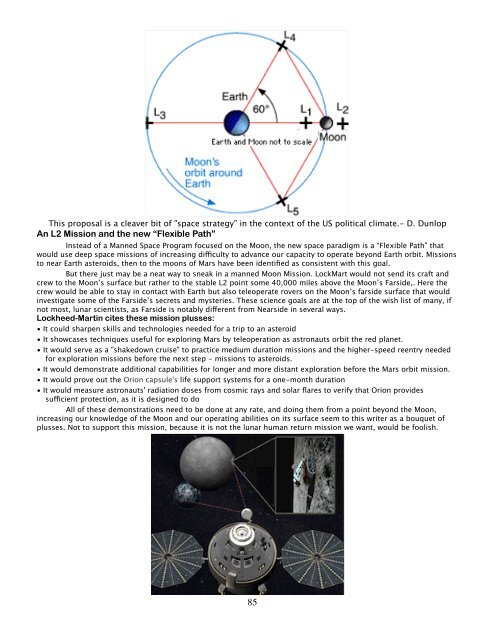Space Transportation - mmmt_transportation.pdf - Moon Society
Space Transportation - mmmt_transportation.pdf - Moon Society
Space Transportation - mmmt_transportation.pdf - Moon Society
You also want an ePaper? Increase the reach of your titles
YUMPU automatically turns print PDFs into web optimized ePapers that Google loves.
This proposal is a cleaver bit of "space strategy” in the context of the US political climate.- D. Dunlop<br />
An L2 Mission and the new “Flexible Path”<br />
Instead of a Manned <strong>Space</strong> Program focused on the <strong>Moon</strong>, the new space paradigm is a “Flexible Path” that<br />
would use deep space missions of increasing difficulty to advance our capacity to operate beyond Earth orbit. Missions<br />
to near Earth asteroids, then to the moons of Mars have been identified as consistent with this goal.<br />
But there just may be a neat way to sneak in a manned <strong>Moon</strong> Mission. LockMart would not send its craft and<br />
crew to the <strong>Moon</strong>’s surface but rather to the stable L2 point some 40,000 miles above the <strong>Moon</strong>’s Farside,. Here the<br />
crew would be able to stay in contact with Earth but also teleoperate rovers on the <strong>Moon</strong>’s farside surface that would<br />
investigate some of the Farside’s secrets and mysteries. These science goals are at the top of the wish list of many, if<br />
not most, lunar scientists, as Farside is notably different from Nearside in several ways.<br />
Lockheed-Martin cites these mission plusses:<br />
• It could sharpen skills and technologies needed for a trip to an asteroid<br />
• It showcases techniques useful for exploring Mars by teleoperation as astronauts orbit the red planet.<br />
• It would serve as a "shakedown cruise" to practice medium duration missions and the higher-speed reentry needed<br />
for exploration missions before the next step - missions to asteroids.<br />
• It would demonstrate additional capabilities for longer and more distant exploration before the Mars orbit mission.<br />
• It would prove out the Orion capsule's life support systems for a one-month duration<br />
• It would measure astronauts' radiation doses from cosmic rays and solar flares to verify that Orion provides<br />
sufficient protection, as it is designed to do<br />
All of these demonstrations need to be done at any rate, and doing them from a point beyond the <strong>Moon</strong>,<br />
increasing our knowledge of the <strong>Moon</strong> and our operating abilities on its surface seem to this writer as a bouquet of<br />
plusses. Not to support this mission, because it is not the lunar human return mission we want, would be foolish.<br />
85















